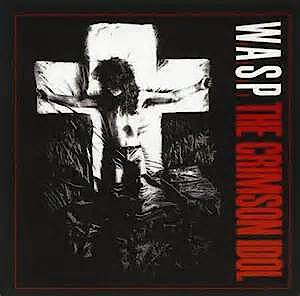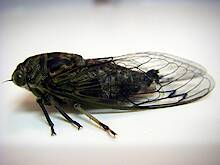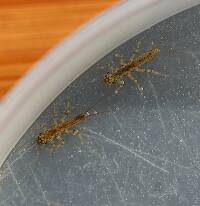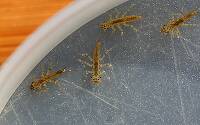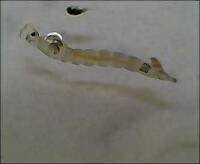
Blue-winged Olives
Baetis
Tiny Baetis mayflies are perhaps the most commonly encountered and imitated by anglers on all American trout streams due to their great abundance, widespread distribution, and trout-friendly emergence habits.
Featured on the forum

With a bit of help from the microscope, this specimen keys clearly and unsurprisingly to Hydropsyche.

Troutnut is a project started in 2003 by salmonid ecologist Jason "Troutnut" Neuswanger to help anglers and
fly tyers unabashedly embrace the entomological side of the sport. Learn more about Troutnut or
support the project for an enhanced experience here.
Adirman on Apr 15, 2013April 15th, 2013, 3:43 pm EDT
Guys:
Im sure that based on my posts title, you probably realize Im no expert entomologist! Considering this, I was hoping that someone might explain what the major difference is between a mayfly "nymph" and a caddis larva? I know that the mayfly does not go through a pupal stage like the caddis to undergo metamorphosis but beyond that, are there some other clear-cut differences that dictate the distinct designation of 1 as nymph and the other as larvae?
Thank you for your patience,
Adirman
P.S. Anyone recommend a good hardcore mayfly/caddis entomology book that is more descriptive with morphology/physiological characteris tics?
Im sure that based on my posts title, you probably realize Im no expert entomologist! Considering this, I was hoping that someone might explain what the major difference is between a mayfly "nymph" and a caddis larva? I know that the mayfly does not go through a pupal stage like the caddis to undergo metamorphosis but beyond that, are there some other clear-cut differences that dictate the distinct designation of 1 as nymph and the other as larvae?
Thank you for your patience,
Adirman
P.S. Anyone recommend a good hardcore mayfly/caddis entomology book that is more descriptive with morphology/physiological characteris tics?
Entoman on Apr 15, 2013April 15th, 2013, 4:43 pm EDT
Hi Adir -
Technically both are larvae. Nymph is a name also in the taxonomic lexicon to define larvae of an hemimetabolous insect whose metamorphosis is incomplete or simple, lacking a pupal stage. Mayflies, stoneflies, damselflies, and dragonflies are aquatic examples of nymphs important to us anglers. To differentiate the post-embryonic immature stages of holometabolous insects like caddis and midges, larva and pupa are the names used.
Hemimetabolous larvae (Nymphs) bear close resemblance to the adult stage.
Holometabolous larvae often appear to be more worm than insect and don't look like the adults at all...
Best books? The good ones like McCafferty's Aquatic Entomology: An Anglers Guide or the even greater detailed Merritt's Aquatic Insects of North America are very expensive. Does anybody know of an eastern equivalent to Hafele/Hughes Western Hatches? It covers the important orders fairly well. Most angler entomology books only cover a single order. I think you can get one fairly cheap (comparatively) at Amazon.
Technically both are larvae. Nymph is a name also in the taxonomic lexicon to define larvae of an hemimetabolous insect whose metamorphosis is incomplete or simple, lacking a pupal stage. Mayflies, stoneflies, damselflies, and dragonflies are aquatic examples of nymphs important to us anglers. To differentiate the post-embryonic immature stages of holometabolous insects like caddis and midges, larva and pupa are the names used.
Hemimetabolous larvae (Nymphs) bear close resemblance to the adult stage.
Holometabolous larvae often appear to be more worm than insect and don't look like the adults at all...
Best books? The good ones like McCafferty's Aquatic Entomology: An Anglers Guide or the even greater detailed Merritt's Aquatic Insects of North America are very expensive. Does anybody know of an eastern equivalent to Hafele/Hughes Western Hatches? It covers the important orders fairly well. Most angler entomology books only cover a single order. I think you can get one fairly cheap (comparatively) at Amazon.
"It's not that I find fishing so important, it's just that I find all other endeavors of Man equally unimportant... And not nearly as much fun!" Robert Traver, Anatomy of a Fisherman
DayTripper on Apr 15, 2013April 15th, 2013, 4:53 pm EDT
I recently picked up Aquatic Entomology on Amazon for like $30 plus shipping. Got my eye on the 2008 version of Merritt's book...
Mayfly nymphs always have two or three tails, caddis larva do not have any tails. Check out some of the photos of each on this website. Once you've looked at a few examples of both, its pretty easy to distinguish one from the other.
Mayfly nymphs always have two or three tails, caddis larva do not have any tails. Check out some of the photos of each on this website. Once you've looked at a few examples of both, its pretty easy to distinguish one from the other.
Crepuscular on Apr 16, 2013April 16th, 2013, 5:49 am EDT
If you are going to delve into to it go with Merritt and Cummins.
Adirman on Apr 16, 2013April 16th, 2013, 12:56 pm EDT
Entoman;
As always, an excellent and most informative post thank you! And thanks to all for the book advice!!
As always, an excellent and most informative post thank you! And thanks to all for the book advice!!
Entoman on Apr 16, 2013April 16th, 2013, 2:21 pm EDT
My pleasure, Adirman. If there is no eastern equivalent, that Hafele book I mentioned will still be very helpful and much more affordable. The fancy ones aren't about your local hatches, either.
"It's not that I find fishing so important, it's just that I find all other endeavors of Man equally unimportant... And not nearly as much fun!" Robert Traver, Anatomy of a Fisherman
Sayfu
Posts: 560
Posts: 560
Sayfu on Apr 17, 2013April 17th, 2013, 5:01 am EDT
Next Tues it looks like I will be emerging my Grannoms. Got to have a couple of twists of my starling hackle behind the head of my emerging pupas.
Tied up some of Lawson's Partridge wing spent caddis as well. Grannoms are coming off on the Henry's Fork.
Quick Reply
Related Discussions
Topic
Replies
Last Reply
2
Apr 7, 2012
by Crepuscular
by Crepuscular
12
Oct 29, 2013
by Macalistair
by Macalistair
Re: Amazon.com ship dates for new edition of Ernest Schwiebert's Nymphs
In General Discussion by Troutnut
In General Discussion by Troutnut
2
Jun 15, 2007
by Taxon
by Taxon


